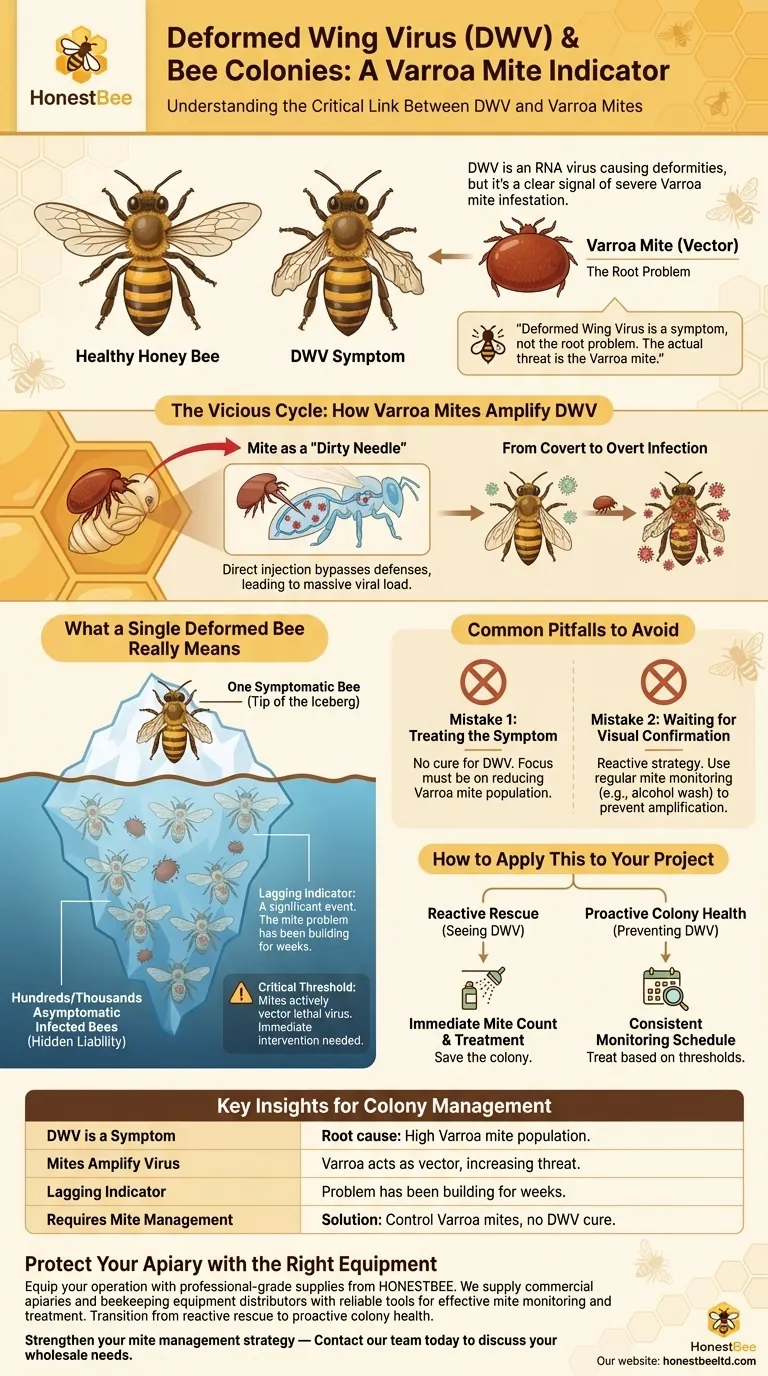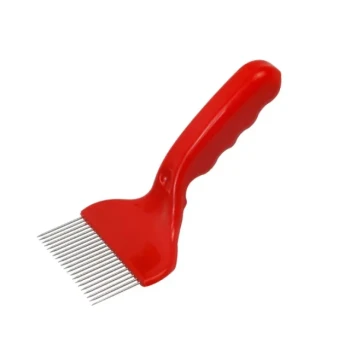At its core, Deformed Wing Virus (DWV) is an RNA virus that causes shrunken, unusable wings and other deformities in honey bees. However, its true significance is not as a disease in itself, but as a clear, visible indicator of a severe and progressed infestation of Varroa mites within your colony. Seeing a bee with DWV is a critical sign that your mite management strategy requires immediate attention.
The most important thing to understand is that Deformed Wing Virus is a symptom, not the root problem. The actual threat to your colony is the Varroa mite, which acts as a vector and amplifier for the virus, turning a low-level infection into a colony-collapsing epidemic.

The Vicious Cycle: How Varroa Mites Amplify DWV
To effectively manage your colonies, you must understand the relationship between the mite and the virus. They work together in a destructive partnership that can rapidly overwhelm a hive's defenses.
The Mite as a "Dirty Needle"
Think of the Varroa mite not just as a parasite, but as a hypodermic needle that injects the virus directly into the bee's circulatory system (hemolymph). While bees can transmit the virus to each other at low levels, this direct injection by a mite is vastly more effective and virulent.
This method of transmission bypasses the bee's natural frontline defenses, leading to a massive viral load that a bee cannot fight off.
From Covert to Overt Infection
DWV often exists in a colony at very low, harmless levels, known as a covert infection. The bees appear perfectly healthy.
However, when a Varroa mite feeds on a developing bee pupa, it simultaneously weakens the bee's immune system and transmits a high dose of the virus. This flips the switch from a harmless covert infection to a deadly overt infection, resulting in the classic physical deformities.
What a Single Deformed Bee Really Means
Spotting even one bee with crumpled wings on your landing board is a significant event. It is a visual alarm bell signaling a much deeper problem that has been building for weeks or months.
A Lagging Indicator of a Wider Problem
The bee with deformed wings is the tip of the iceberg. For every one symptomatic bee you see, there are likely hundreds or thousands of asymptomatic bees that are also infected.
These seemingly healthy bees have shortened lifespans, reduced foraging capabilities, and impaired immune function. They are the hidden liability that weakens the colony from within, making it vulnerable to collapse, especially during winter.
A Sign of a Critical Threshold
The presence of DWV indicates that the Varroa mite population in your colony has crossed a critical threshold. At this stage, the mites are not just feeding on bees; they are actively vectoring a lethal virus throughout the brood.
While the reference notes these mite levels are not "unmanageable," it means the time for preventative measures is over. You are now in a reactive situation that demands urgent intervention.
Common Pitfalls to Avoid
Misinterpreting the significance of DWV is a common and often fatal mistake for a colony. Understanding these pitfalls is critical for effective beekeeping.
Mistake 1: Treating the Symptom, Not the Cause
There is no treatment or cure for Deformed Wing Virus itself. Attempting to solve a DWV problem without addressing the mites is like trying to fix malaria without controlling the mosquitos. Your entire focus must be on testing for and reducing the Varroa mite population.
Mistake 2: Waiting for Visual Confirmation
Using visual sightings of DWV as your trigger to treat for mites is a reactive strategy that guarantees you are always one step behind. Proactive beekeeping relies on regular mite monitoring (like alcohol washes or sugar rolls) to keep Varroa populations low before they can amplify the virus to lethal levels.
How to Apply This to Your Project
Your response to DWV should be determined by when and how you see it. Your goal is to move from a reactive to a proactive management strategy.
- If your primary focus is reacting to a bee with DWV: Your immediate goal is rescue. Conduct an immediate mite count and be prepared to apply an effective Varroa treatment right away to save the colony.
- If your primary focus is proactive colony health: Your goal is prevention. Stick to a consistent schedule of Varroa mite monitoring and treat based on established thresholds, long before viruses have a chance to become a visible problem.
Ultimately, viewing DWV as a direct signal of your colony's Varroa load is the key to making timely and effective management decisions.
Summary Table:
| Key Insight | What It Means for Your Colony |
|---|---|
| DWV is a Symptom | The root cause is a high Varroa mite population, not the virus itself. |
| Mites Amplify the Virus | Varroa mites act as a vector, turning a low-level infection into a colony threat. |
| A Lagging Indicator | Seeing one bee with DWV means the mite problem has been building for weeks. |
| Requires Mite Management | The solution is to control Varroa mites, as there is no cure for DWV. |
Protect Your Apiary with the Right Equipment
Seeing signs of DWV means it's time for decisive Varroa management. Equip your operation with professional-grade supplies from HONESTBEE. We supply commercial apiaries and beekeeping equipment distributors with the reliable tools needed for effective mite monitoring and treatment, helping you transition from reactive rescue to proactive colony health.
Strengthen your mite management strategy — Contact our team today to discuss your wholesale needs.
Visual Guide

Related Products
- High Performance Plastic Queen Excluder for Beekeeping and Apiary Management
- Nicot Queen Rearing Kit for Beekeeping and Grafting in Nicot System
- Professional Plastic Queen Excluder for Modern Beekeeping
- Metal Queen Bee Excluder for Beekeeping
- Jenter Queen Rearing Kit Complete Set for Bee Breeding
People Also Ask
- What are the benefits of a queen excluder? Ensure Pure Honey & Simplify Hive Management
- When is the typical time frame for harvesting honey and removing the queen excluder? Optimize Your Hive Management
- What happens if I don't use a queen excluder? Understand the impact on your honey harvest.
- What impact does a queen excluder have on colony defensiveness? Control Hive Temperament for Safer Beekeeping
- When is the best time to place a queen excluder? Optimize Honey Production & Purity



















